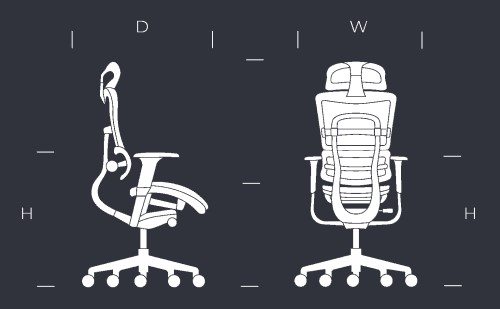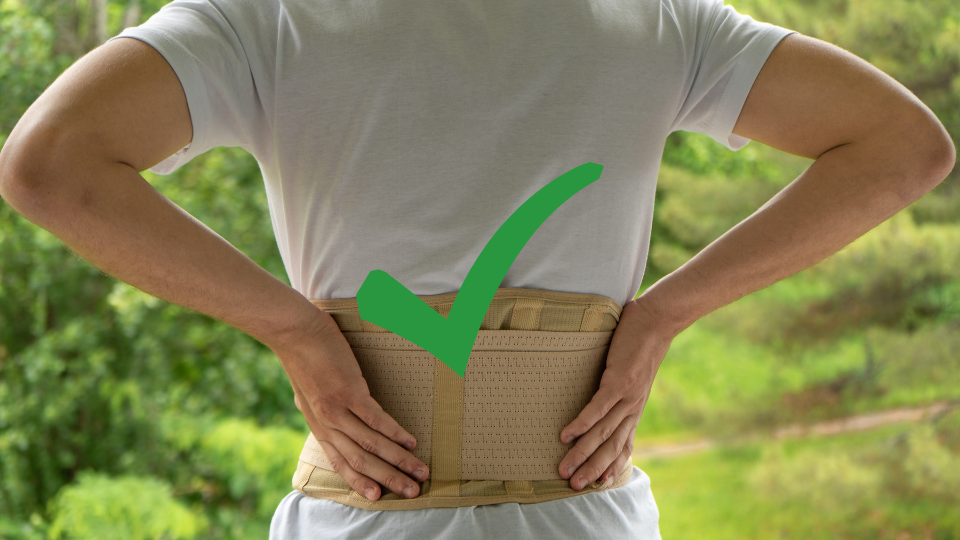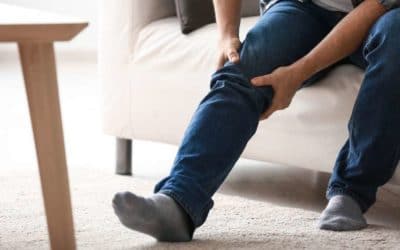When you’re sitting at your desk, does your back feel supported? Many people experience discomfort in their lower back, which can be attributed to a lack of lumbar support while sitting. So, the big question is – where should lumbar support be placed on office chairs? Keep reading to find out!
As a general rule, lumbar support on office chairs should be placed at the lower back’s natural curve, around the waistline. Adjustable lumbar support is important to accommodate different body types and preferences. Users should feel supported without discomfort or being pushed forward.
It is important to figure out where lumbar support should be placed on office chairs. I have some simple solutions for you! My YouTube channel, 30 years of Chiropractic practice, trained ergonomist, published book, engineered solutions, and successful Kickstarter campaign makes me an expert on this subject!
All Day Comfort & Support
How to Get Your Posture Right When Seated
We seldom think about our posture until we feel pain in our backs or necks. On the other hand, an unhealthy posture can lead to headaches, fatigue, and muscle strain. It is possible to improve your posture and reduce your risk of back pain by following a few simple steps.

Black Friday: 35% Off Today
Typical Delivery 1-3 Days
How Do You Attach a Pillow Support to a Chair?
Many different techniques can be used to attach lumbar support to a chair. One standard method is to use long, adjustable straps that loop around the sides and back of the chair. These straps can be tightened or loosened using small metal buckles or tensioning devices, allowing you to achieve firmness and support that sweet spot in the small of your back.
Another option is to use solid panels with embedded cushions and Velcro straps, which makes it easy to fine-tune the positioning of the lumbar support. Additionally, these panels can often be removed for washing or replaced with new ones, making them a very convenient option. Ultimately, there are many ways to attach lumbar support to a chair, so choosing the best approach for your particular needs is essential.
How Do You Set Up Lumbar Cushion? | Ergonomic Office Support
To set up lumbar support in your car or at home, you will first need to identify the areas of your body that need additional support. This may include the lower back, mid-back, or neck and shoulders. It is important to find a comfortable position before you begin attaching any additional supports. Next, select an appropriate cushion or pad, depending on the location, which needs additional support. Some options include pillows filled with gel or memory foam, foam blocks, or specially designed cushions for your body type. The best choice is always natural latex!
Once you have chosen an appropriate cushion or pad, attach it to your seat using straps, hooks, or Velcro if available. Make any adjustments necessary to ensure a snug and secure fit around your body. With proper lumbar support, you can enjoy more comfortable driving or sitting at home for extended periods with less risk of back pain or discomfort.
All Day Comfort & Support
Does Lumbar Support Cushions Work?
Lumbar support cushions are a popular option for those looking for relief from lower back pain. While there is some evidence that they can help to reduce pain and improve posture, it is important to note that not all cushions are created equal. * It is recommended to choose a high-quality cushion that offers proper support and to combine its use with other treatments such as exercise and stretching for the best results.
Why Is Lumbar Support Uncomfortable?
When it comes to finding relief from lower back pain, people will try just about anything. From medications to acupuncture, there are a variety of treatments available. One popular option is the lumbar support cushion. But do these cushions really work?
There is some evidence that lumbar support cushions can help to relieve back pain. One study found that participants who used a lumbar support cushion reported less pain and disability than those who did not use a cushion. Additionally, lumbar support cushions can help to improve posture and prevent strained muscles. However, it is essential to note that not all lumbar support cushions are created equal. Be sure to choose a high-quality cushion that offers proper support. Additionally, lumbar support cushions are not a cure-all for back pain. They should be used in combination with other treatments, such as exercise and stretching, to achieve the best results.
How Do You Use a Lumbar Support Belt?
A lumbar support belt is a valuable tool for anyone who suffers from back pain. Such belts help to provide extra support for the lower back, helping to relieve discomfort and prevent strain and injury. Typically, a lumbar support belt is worn around the waist, with straps that extend up over the shoulders. This enables it to provide targeted support to the lower back region, where most of the body’s weight and stress are concentrated.
When used properly, a lumbar support belt can help to reduce tension in your back and improve posture, allowing you to go about your daily activities more comfortably and with less risk of injury. Whether you use your lumbar support belt while sitting at your desk or lifting heavy objects, it can be an indispensable tool for managing and preventing back pain. So if you are looking for relief from chronic or occasional back pain, consider using a quality lumbar support belt. It could make all the difference!
Black Friday: 35% Off Today
Typical Delivery 1-3 Days
Why Do Desk Chairs with Lumbar Support Hurt My Back?
It’s a common conundrum. If you start experiencing back pain, buy a chair with lumbar support. But instead of providing relief, the chair makes your back pain worse. Why is this?
There are a few possible explanations. First, it’s possible that the lumbar support is too aggressive for your particular spine. When your lower back is pressed against the support, it can cause the muscles and ligaments in your back to tense up, which can lead to more pain. Second, the support may be preventing you from assuming a proper sitting position. When you slouch in your chair, it strains your spine; however, the lumbar support can block you from slouching, leading to discomfort. Finally, it’s also possible that the chair itself is to blame. If the seat is too hard or the armrests are too low, it can cause pain without lumbar support.
If you’re struggling with back pain, you can do a few things. First, try adjusting the lumbar support on your chair until you find a comfortable position. Second, get an ergonomic seat cushion. Finally, take breaks often to walk around and stretch your back.
Does Everyone Need a Lumbar Pillow? | Back Support
There is no one correct answer to whether everyone needs lumbar support. Some people might find that lumbar support relieves back pain, while others might not experience any significant benefits. Factors like body type, posture, and specific spinal issues can affect how effective a particular type of support will be for an individual. Ultimately, the key is to work closely with your chiropractor or physical therapist to figure out what measures are best for your particular situation.
If you are experiencing back pain or general discomfort, however, investing in some form of lumbar support may be a good idea. These supports can help to restore proper curvature to your spine and alleviate pressure on the lower back, thereby easing stress on muscles and joints. So if you’re struggling with back problems, don’t hesitate to try out different forms of lumbar support; you never know which one could provide the perfect solution!
Which Lower Back Lumbar Pillow Is Best for Office Chairs?
When it comes to finding relief from lower back pain, people will try various options. One popular option is the lumbar support cushion. But it’s important to note that not all lumbar support cushions are created equal, be sure to choose a high-quality cushion that offers proper support. Additionally, lumbar support cushions are not a cure-all for back pain. They should be combined with other treatments, such as exercise and stretching, to achieve the best results. Factors like comfort, design, and materials all play a role in determining what will work best for you. It is important to do your research and select the best option for you.
How Much Lumbar Support Is Too Much?
At first glance, the idea of lumbar support might seem like a no-brainer. After all, who wouldn’t want to add some extra support for their lower back? But the truth is that if you have too much lumbar support in your chair or car seat, it can actually do more harm than good. Not only does over-supporting your lower back limit your body’s natural range of motion, but it can also lead to a condition called “lower back syndrome.”
The spine becomes excessively rounded and stiff due to constant compression and limited movement. To avoid these problems, it is vital to strike a balance between lumbar support and freedom of movement. So how much lumbar support is too much? The answer will likely depend on your individual needs and preferences. Ultimately, you should aim to create an environment that feels supportive without being constrictive. With this approach, you can help ensure that your lower back stays healthy and happy for years to come!
What Is the Correct Way to Sit in an Office Chair? Adjustable Lumbar Support
Most people spend most of their day sitting in an office chair, yet few think about how to sit in one. You should keep a few things in mind if you want to maintain good posture and avoid pain or discomfort. First, adjust the seat height so that your feet are flat on the ground and your thighs are parallel to the floor. Next, adjust the backrest to support your lower back in a natural position. You may also consider using a lumbar support pillow to protect your back. Finally, ensure that your arms are resting comfortably at your sides and that your wrists are in line with your keyboard. Following these simple instructions can help ensure that you sit correctly in your office chair and avoid any potential health problems.
Most back pain problems are caused by these factors:
I have observed as a chiropractor that back pain can be classified into acute and chronic. Acute back pain usually subsides within a few days to a few weeks, while chronic back pain lasts at least a year.
Lower back pain is the most prevalent type of back pain. This type of pain can be caused by a variety of factors, including:
- congenital skeletal abnormalities such as scoliosis, lordosis, and kyphosis
- degenerative conditions like arthritis, spondylosis, and disc degeneration.
- Other potential causes of low back pain include spinal problems like sciatica, ruptured discs, spinal stenosis, spondylolisthesis, and osteoporosis.
- Additionally, conditions like piriformis syndrome, fibromyalgia, endometriosis, pregnancy, and tumors can also contribute to back pain.
A sedentary lifestyle and poor posture, as well as lifestyle factors such as prolonged sitting without proper back support, being overweight, or aging, can contribute to back pain.
A healthy back is maintained by maintaining good posture while sitting during the day and sleeping in a comfortable position at night. Regular exercise and movement can also help prevent back pain. As a healthcare provider, I recommend my patients follow these lifestyle practices to maintain good back health, including getting enough quality sleep.
Back Pain Warning Signals
There exist various indications that suggest the presence of severe back pain, which may require medical attention, even though some instances of back pain can be treated with self-care. These warning signs include having a fever alongside back pain, feeling numbness in the groin region, experiencing sudden weakness in the legs, having a loss of control over bladder or bowel movements, being unable to find a comfortable sitting or standing position, and experiencing progressively worsening pain instead of a reduction in pain. It is crucial to seek prompt medical intervention if any of these symptoms manifest.
Summary
All things considered, finding the most comfortable and ergonomic position for your office chair can be a challenge. It is important to take into account the shape of one’s lumbar spine when accessing external lumbar support for their chairs or when utilizing a standing desk. To get the most out of your office chair, make sure that the top of the support should line up with the curve in your back and adjust it so that the hips are above the knees while ensuring that the bottom is placed 2-3 inches below your waistline. Achieving a healthy posture while at work can help ensure that you don’t experience any serious complications related to compromising your back’s anatomy by sitting in an unsuitable desk chair.
When selecting chairs for the office, it is essential to consider ergonomics, and the lumbar support should be placed at the lower back to provide comfort and prevent pain and discomfort, whether you choose a traditional office chair or an ergonomic chair, for sitting or standing desks.
Sources:
- Thoumie, P., Drape, J.L., Aymard, C. and Bedoiseau, M., 1998. Effects of a lumbar support on spine posture and motion assessed by electrogoniometer and recording. Clinical biomechanics, 13(1), pp.18-26.
- Coleman, N., Hull, B.P. and Ellitt, G., 1998. An empirical study of preferred settings for lumbar support on adjustable office chairs. Ergonomics, 41(4), pp.401-419.
- Makhsous, M., Lin, F., Bankard, J., Hendrix, R.W., Hepler, M. and Press, J., 2009. Biomechanical effects of sitting with adjustable ischial and lumbar support on occupational low back pain: evaluation of sitting load and back muscle activity. BMC musculoskeletal disorders, 10(1), pp.1-11.
- Snijders, C.J., Hermans, P.F., Niesing, R., Spoor, C.W. and Stoeckart, R., 2004. The influence of slouching and lumbar support on iliolumbar ligaments, intervertebral discs and sacroiliac joints. Clinical Biomechanics, 19(4), pp.323-329.







